Last updated on March 1, 2013
As the pace of events is winding down in Fukushima so are our updates.
JAIF and NISA updated data below in the table, click the links to see the time graphs from the FNPP1 blog:
| Reactor 1 | Reactor 2 | Reactor 3 | |
| Water level (meter)* | -1.7 | -2.1 | -2.25 |
| Flow rate(m3/min) | 6 | 7 | 6.5 |
| Core pressure (kPa) | 1175 | – | – |
| Containment pressure (kPa) | 105 | 75 | 103.3 |
| Wetwell pressure (kPa) | 105 | – | 179.6 |
| Feedwater nozzle temp (Celsius) | 114.7 | 119.2 | 80.6 |
| Bottom head temp (Celsius) | 95.0 | – | 112.9 |
| Containment dose rate (Sv/hour) | – | 24.8 | 17.0 |
| Wetwell dose rate (Sv/hour) | 1.5 | 0.371 | 0.527 |
| *Distance from top of assembly | |||
| – broken gauges or missing data |
Temperatures, pressures etc look quite stable. Pumping of water form the tunnel connected to the number 2 turbine building is marginally successful. Spraying of a resin to bind down radioactive material to the ground, and prevent it from stirring up into the air, is ongoing all over the plant area. TEPCO has managed to get a camera in to investigate the number 4 spent fuel pool and world nuclear news report that the damage is limited, below is a picture from WNN of the pool.

Atomic Power Review writes that NISA has doubts about TEPCO’s plans to flood the containments. The doubt is regarding the structural integrity of the containments with the added strain from such a huge amount of water. Flooding the containment is a part of TEPCO’s plan to restore recirculation cooling to the reactor so it will be crucial to see how TEPCO responds to NISA and if they can show the containments can handle it. If they can not show it conclusively, then they will have to devise a new plan on how to restore cooling. In my last post I was questioning why they would want to flood the containments in the first place, but then realized that if the reactor vessels are broken and leaking, then the only way to submerge the fuel completely is to raise the level of water in the containment to the same level as the top of the fuel assemblies within the reactor vessel. I don’t see why this would be needed for the number one reactor, since it seems like it is holding pressure very well and must be pretty intact. But might be the only way for the number 2 and 3 reactors.
Over at The neutron economy one can read a blog post on the expected first yearly dose relased by the US department of energy, below is a map of it.
The dose rate is based on the following assumptions:
- Assumes no reduction for spending time indoors
- Takes into account decay of the radionuclides
- Takes into account gamma ray from ground deposits and inhalation of stirred up particles from the ground
The map is using the common american unit millirem. One millirem is equal to 0.01 millisievert. The red area marks the area where one would get more than 20 mSv/year if one lives there given the above assumptions. Yellow area is 10-20 mSv, green area is 5-10 mSv and blue area 1-5 mSv. Neutron Economy also shows a picture with more detail of the over 20 mSv area that can be found in this link. Close to the plant it will be up to 200 mSv and in some hot areas 100 mSv. Some of the hot areas are outside of the initial 20 km evacuation zone and that explain the new evacuation areas. It is not immiedietly dangerous to be in those areas but one probably does not want to live there. It will be interesting to hear what plans will be made to clear out the areas. Outside of Fukushima dose rates are down to natural backgrounds levels according to IAEA. Seems like bans on shipping of most kind of food products have been lifted.
More information about exposed workers have been released, so far it looks like this:
- 200 – 250 mSv 2 workers
- 150 – 200 mSv 8 workers
- 100 – 150 mSv 11 workers
In summary one can say that the situation as far as radiation levels are concerned is improving. Radiation levels are decreasing everywhere. The situation with the reactors are fairly stable, but long term cooling is still a big question mark.
/Johan
Links(English)
World Nuclear News No significant damage to fuel at unit 4
Blogs(English)
NEI Nuclear NotesWeekly Updated
Atomic Power Review NISA instruction to TEPCO
The Neutron Economy Expected Doses Over a Year and Evacuation of Fukushima Towns
Blogs(Swedish)
Dagens Kotka Tre härdsmältor på samma plats
Fourfact webloggen Naturligt kärnkraftsmoratorium
Stockholmscollage Vad har uranpolitikerna att frukta
Svensson En annan värld – kampen mot kärnkraft
Akkomp’s blogg Som ett smycke
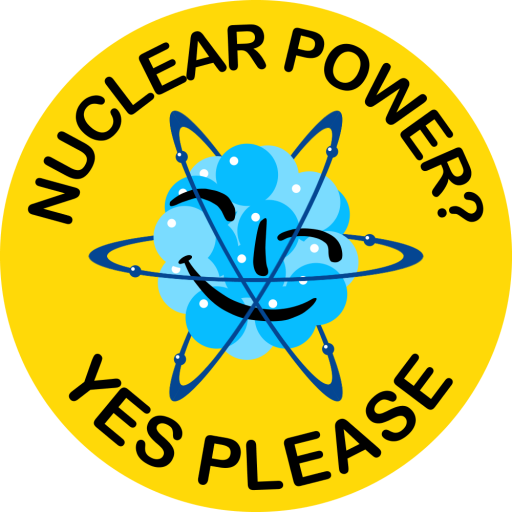
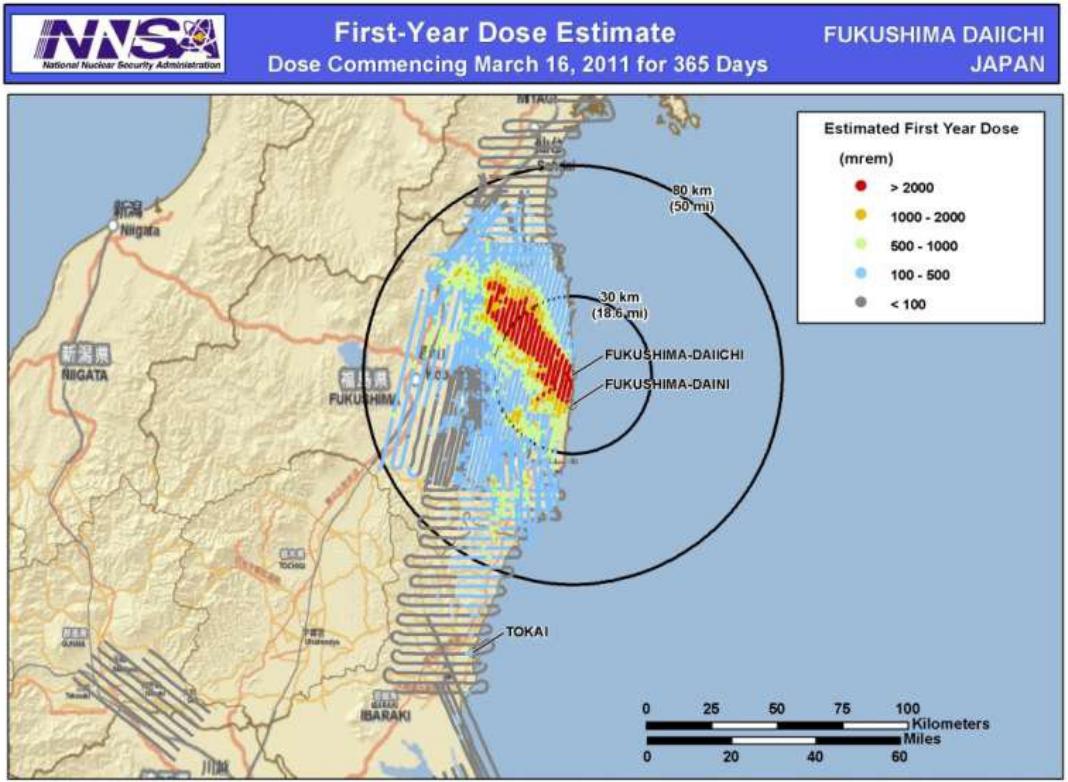


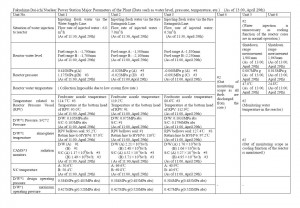
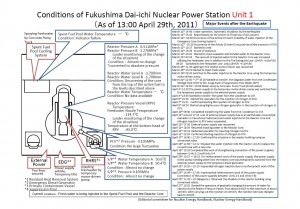
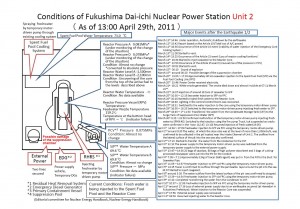

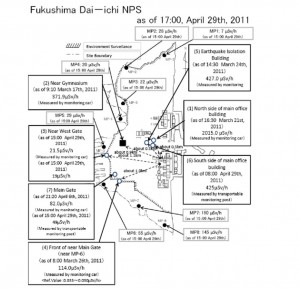
Warning: Declaration of Social_Walker_Comment::start_lvl(&$output, $depth, $args) should be compatible with Walker_Comment::start_lvl(&$output, $depth = 0, $args = Array) in /var/www/nuclearpoweryesplease.org/public_html/blog/wp-content/plugins/social/lib/social/walker/comment.php on line 18
Warning: Declaration of Social_Walker_Comment::end_lvl(&$output, $depth, $args) should be compatible with Walker_Comment::end_lvl(&$output, $depth = 0, $args = Array) in /var/www/nuclearpoweryesplease.org/public_html/blog/wp-content/plugins/social/lib/social/walker/comment.php on line 42
Any collective dose estimates yet that pass a minimum quality test?
Not that I have seen. I guess nobody knows yet how the population will be relocated, how many will move back into contaminated areas etc.
“Prediction is very difficult, especially about the future.” Niels Bohr
But by now, I would like to see some well done estimates of the collective dose to people so far. The future is obviously a bit more complicated to estimate.
Still, if I were a politician in charge of deciding to evacuate or not, I would be _really_ interested in knowing if I any evacuation would prevent 0.5 fatal cancers, or 500 fatal cancers.
Numbers means a lot for actual humans. Some people think that statistics is cold blooded… but behind every little number in this case is a real human. Somewhere. I would not bother making people nervous about 0.5 estimated fatal cancers.
If you subscribe to LNT theory, as I do, there is still a big difference if you have a quite small dose to the public, or a quite large one. According to LNT, no dose of radiation is harmless, but there are very big differences in harm done from different doses.
I still think the most reasonable approach would be to forget about collective dose and talk individual risks. Even the ICRP advise against using collective dose to estimate future cancer rates and that it should be mostly use for ALARA(as low as reasonably achievable) purposes. Better would be to use individual dose and compare it to background and set some limit that is deemed acceptable on a personal risk basis.
Or simply inform the evacuees about the personal risk from such and such dose and let them decide if they find it acceptable or not to move back or if they prefer to get a new home somewhere else payed for in full by TEPCO. One should not underestimate peoples ability to make decisions for themself.
Sorry about thread necromancy Johan, but do you have a link to a good text from ICRP, about why they do not think using collective doses is a good way to estimate future cancers?
http://www3.nhk.or.jp/daily/english/03_20.html
“The science ministry uses a computer system called SPEEDI to predict how radiation will spread depending on weather and geographical conditions.”
“…”
“Such data had been withheld for fear of causing panic.”
The SPEEDI data was reported a while ago, I remember writing about it on the blog. The total dosages where quite high. 100 mSv to the most exposed if I remember right. But the assumptions they where using where quite severe. Can’t remember in which update I wrote about it.
Of course these problems are up to the Japanese government and authorities to decide. But it is probably useful to discuss.
Authorities estimate the harm of radiation in small doses to one dead per 20 ManSv collective dose. An equivalent statement is that a dose 100 mSv to an individual will kill the exposed individual with probability 0.005. This is probably a sufficient reason for forced evacuation which is planned to be permanent and a restricted access area controlled with emergency laws. But still the chance to die for other reasons than radiation is considerable higher and if radiation kills, it probably does so first in 15 years. For those who prefer population numbers it can be formulated that evacuating 10 000 people saves 50 lives (more if evacuated for all future and no repopulation allowed), but I think it is better to view it on the level of individuals.
If the predicted dose is 10 mSv the probability to get killed is 0.0005, which is small compared to other variations in mortality. Actually the risk is lower as people are most of the time indoors or in less exposed areas and actions for decontaminating areas where people spend most of their time will occur. So it seems better to me to leave decisions to individuals without too much governmental interference. The consequences of moving is drastically different for different individuals, the risk vs. benefit decisions are not best made by the government, if the risk is not very large. The risk varies among individuals, e.g. the risk for children and youth is higher. Retired people often die for other reasons before a radiation induced cancer kills them. To me there does not seem to be a need to continue to forbid people to return to areas where predicted first year dose is below 10 mSv, if the risk for new large releases to the air is small.
The legal limit between different actions as well as individual decisions should be based on the best available information. There is a problem that it is so little agreement about the risks. In spite of so much research under so long time and in spite of that radiation is easy to measure. In spite of what we learned from Chernobyl my feeling is that the decisions would be similar if Chernobyl did not happen, thus we learnt little. This really gets me worried about the exposure of Mankind for all other type of things, which we know much less about and is more difficult to measure.
I remember reading this about a month ago. One can only hope TEPCO has improved conditions since then.
The press release is from May 04,2011.
At the bottom of it, there is a link with more detailed information on the work environment at different places.
http://www.tepco.co.jp/en/press/corp-com/release/betu11_e/images/110504e12.pdf
As I read it, there are at this date several places where you can not take a shower.
1) To work well, it helps if you have slept well, are well fed, feel clean, and are competently led.
2) If TEPCO can not fix things like food and showers by now, imho, it shows serious deficiencies in their management competence.
I wonder if they accept the help that they are offered.
The Japanese workers trying to handle this situation are forced to work under bad conditions:
“Workers endure austere conditions in averting nuclear disaster”
http://edition.cnn.com/2011/WORLD/asiapcf/03/29/japan.nuclear.workers/
“Tokyo (CNN) — They sleep anywhere they can find open space — in conference rooms, corridors, even stairwells. They have one blanket, no pillows and a leaded mat intended to keep radiation at bay.
They eat only two meals each day — a carefully rationed breakfast of 30 crackers and vegetable juice and for dinner, a ready-to-eat meal or something out of a can.They clean themselves with wet wipes, since the supply of fresh water is short.”
You can not work well in an environment like this, especially not if you are stressed. How do you decontaminate yourself if you do not have good access to water?
And how on earth do you do your laundry without access to water… Keeping yourself and your clothes is relay important, if you work in a radiologically contaminated environment.
TEPCO is trying to improve working conditions, but you can not call it quick though:
http://www.tepco.co.jp/en/press/corp-com/release/11050409-e.html
“Also at J-Village” “…” “showers will be made partly available by the late May, and more showers and toilets will be made available by the end of June.”
You really want the workers being able to concentrate on their work, instead of their living conditions.